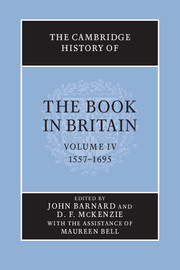Book contents
- Frontmatter
- Dedication
- Contents
- List of illustrations
- List of contributors
- Preface
- Acknowledgements
- Introduction
- RELIGION AND POLITICS
- ORAL TRADITIONS AND SCRIBAL CULTURE
- LITERATURE OF THE LEARNED
- LITERARY CANONS
- VERNACULAR TRADITIONS
- THE BUSINESS OF PRINT AND THE SPACE OF READING
- 26 Printing and publishing 1557–1700: constraints on the London book trades
- 27 The economic context
- 28 French paper in English books
- 29 The old English letter foundries
- 30 Bookbinding
- 31 Mise-en-page, illustration, expressive form
- BEYOND LONDON: PRODUCTION, DISTRIBUTION, RECEPTION
- DISRUPTION AND RESTRUCTURING: THE LATE SEVENTEENTH-CENTURY BOOK TRADE
- STATISTICAL APPENDICES
- Abbreviations
- Bibliography
- Index
- Plate Section
- References
31 - Mise-en-page, illustration, expressive form
from THE BUSINESS OF PRINT AND THE SPACE OF READING
- Frontmatter
- Dedication
- Contents
- List of illustrations
- List of contributors
- Preface
- Acknowledgements
- Introduction
- RELIGION AND POLITICS
- ORAL TRADITIONS AND SCRIBAL CULTURE
- LITERATURE OF THE LEARNED
- LITERARY CANONS
- VERNACULAR TRADITIONS
- THE BUSINESS OF PRINT AND THE SPACE OF READING
- 26 Printing and publishing 1557–1700: constraints on the London book trades
- 27 The economic context
- 28 French paper in English books
- 29 The old English letter foundries
- 30 Bookbinding
- 31 Mise-en-page, illustration, expressive form
- BEYOND LONDON: PRODUCTION, DISTRIBUTION, RECEPTION
- DISRUPTION AND RESTRUCTURING: THE LATE SEVENTEENTH-CENTURY BOOK TRADE
- STATISTICAL APPENDICES
- Abbreviations
- Bibliography
- Index
- Plate Section
- References
Summary
The study of the printed page as expressive form is a relatively recent development. The case studies presented here indicate, albeit briefly, something of the rich potential of such a study and draw attention to the physicality of the book as an agent in shaping the meaning and interpretation of text. The material form by which text reaches reader – and written texts can scarcely exist apart from their embodiment in material form – is necessarily historically specific, constrained by the currently available technologies of paper, ink, print, illustration and binding. But it is also historically specific in its participation in, imitation of, or challenge to a set of typographical conventions shared and understood by the text’s producers, buyers and readers.
All aspects of the text’s physical form are capable of constituting meaning. Choices of paper, format, type, ornament, illustration, binding and page layout were made by one or more agents, singly or collaboratively: author, compositor, printer, publisher, editor and (especially in the case of bindings) buyer and reader. Such choices were necessarily constrained by local economic circumstances. In his study of the Cambridge University Press, for example, David McKitterick notes that the ‘cramped effect, of small sizes of type occupying as much of the page as possible’ of much seventeenth-century Cambridge printing was due to the ‘penny-pinching’ of its printers; and that the 1629 Cambridge Bible ‘embodied a series of typographical decisions whose principal intention was…to economize within a framework established by convention.’ Such economies were typical of an undercapitalized English trade whose staple income came from small-format books (school books, ABCs, almanacs and prognostications) and an increasingly wide repertoire of ephemeral items (pamphlets, ballads, newsbooks and jobbing printing) which realized a quick return.
- Type
- Chapter
- Information
- The Cambridge History of the Book in Britain , pp. 632 - 662Publisher: Cambridge University PressPrint publication year: 2002
References
- 9
- Cited by

